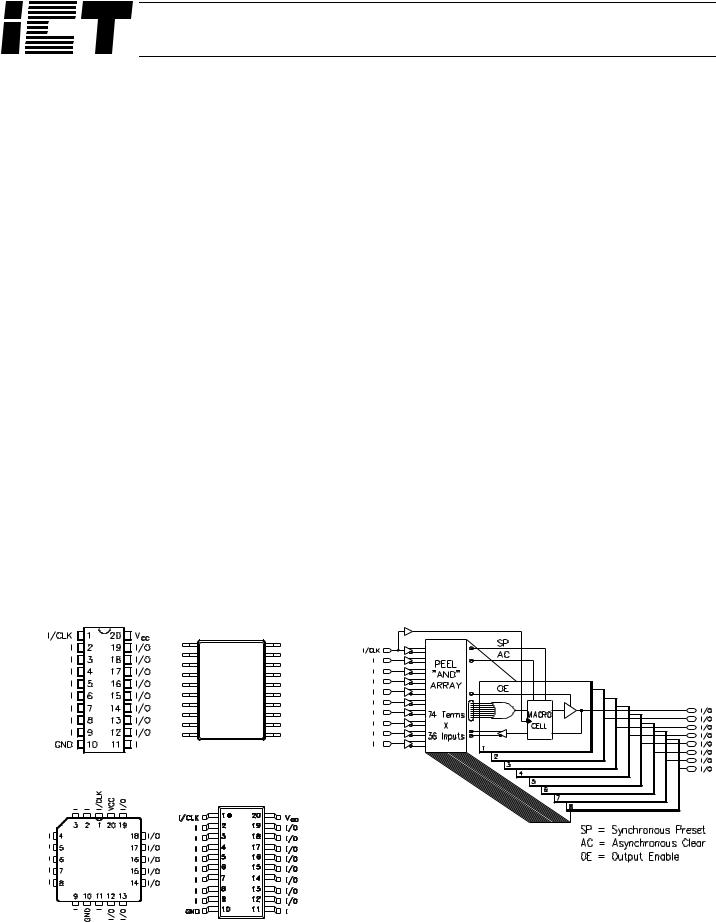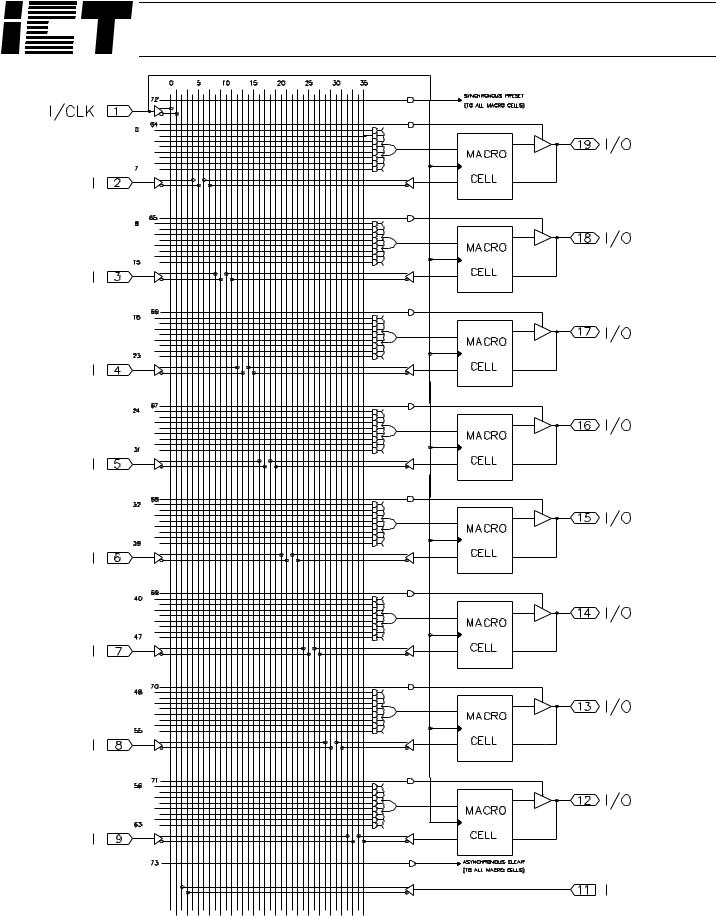ICT PEEL18CV8J-10, PEEL18CV8J-15, PEEL18CV8J-25, PEEL18CV8PI-25, PEEL18CV8PI-5 Datasheet
...
Commercial/
Industrial
PEEL™ 18CV8 -5/-7/-10/-15/-25
CMOS Programmable Electrically Erasable Logic Device
Features
■Multiple Speed Power, Temperature Options
-VCC = 5 Volts ±10%
-Speeds ranging from 5ns to 25 ns
-Power as low as 37mA at 25MHz
-Commercial and industrial versions available
■CMOS Electrically Erasable Technology
-Superior factory testing
-Reprogrammable in plastic package
-Reduces retrofit and development costs
■Development / Programmer Support
-Third party software and programmers
-ICT PLACE Development Software and PDS-3 programmer
-PLD-to-PEEL™ JEDEC file translator
■Architectural Flexibility
-Enhanced architecture fits in more logic
-74 product terms x 36 input AND array
-10 inputs and 8 I/O pins
-12 possible macrocell configurations
-Asynchronous clear
-Independent output enables
-- 20 Pin DIP/SOIC/TSSOP and PLCC
■Application Versatility
- Replaces random logic
- Super sets PLDs (PAL, GAL, EPLD)
- Enhanced Architecture fits more logic than ordinary PLDs
General Description
The PEEL™18CV8 is a Programmable Electrically Erasable Logic (PEEL™) device providing an attractive alternative to ordinary PLDs. The PEEL™18CV8 offers the performance, flexibility, ease of design and production practicality needed by logic designers today.
The PEEL™18CV8 is available in 20-pin DIP, PLCC, SOIC and TSSOP packages with speeds ranging from 5ns to 25ns with power consumption as low as 37mA. EE-Repro- grammability provides the convenience of instant reprogramming for development and reusable production inventory minimizing the impact of programming changes or errors. EE-Reprogrammability also improves factory testability, thus assuring the highest quality possible.
The PEEL™18CV8 architecture allows it to replace over 20 standard 20-pin PLDs (PAL, GAL, EPLD etc.). It also provides additional architecture features so more logic can be put into every design. ICT’s JEDEC file translator instantly converts to the PEEL™18CV8 existing 20-pin PLDs wit hout the need to rework the existing design. Development and programming support for the PEEL™18CV8 is provided by popular third-party programmers and development software. ICT also offers free PLACE development software and a low-cost development system (PDS-3).
Figure 2 |
Pin Configuration |
|
|
Figure 3 Block Diagram |
|
|
I/CLK |
1 |
20 |
VCC |
|
|
I |
2 |
19 |
I/O |
|
|
I |
3 |
18 |
I/O |
™ |
|
|
||||
|
I |
4 |
17 |
I/O |
|
|
I |
5 |
16 |
I/O |
|
|
I |
6 |
15 |
I/O |
|
|
I |
7 |
14 |
I/O |
|
|
I |
8 |
13 |
I/O |
|
|
I |
9 |
12 |
I/O |
|
|
GND |
10 |
11 |
I |
|
DIP |
TSSOP |
|
|
|
|
PLCC |
SOIC |
1 of 10

PEELTM 18CV8
Figure 4 PEEL™18CV8 Logic Array Diagram
2 of 10

PEELTM 18CV8
Function Description
The PEEL™18CV8 implements logic functions as sum-of- products expressions in a programmable-AND/fixed-OR logic array. User-defined functions are created by programming the connections of input signals into the array. Userconfigurable output structures in the form of I/O macrocells further increase logic flexibility.
Architecture Overview
The PEEL™18CV8 architecture is illustrated in the block diagram of Figure 3. Ten dedicated inputs and 8 I/Os provide up to 18 inputs and 8 outputs for creation of logic functions. At the core of the device is a programmable electrically-erasable AND array which drives a fixed OR array. With this structure, the PEEL™18CV8 can implement up to 8 sum-of-products logic expressions.
Associated with each of the 8 OR functions is an I/O macrocell which can be independently programmed to one of 12 different configurations. The programmable macrocells allow each I/O to create sequential or combinatorial logic functions of active-high or active-low polarity, while providing three different feedback paths into the AND array.
AND/OR LOGIC ARRAY
The programmable AND array of the PEEL™18CV8 (shown in Figure 4) is formed by input lines intersecting product terms. The input lines and product terms are used as follows:
■36 Input Lines:
-20 input lines carry the true and complement of the signals applied to the 10 input pins
-16 additional lines carry the true and complement values of feedback or input signals from the 8 I/Os
■74 product terms:
-64 product terms (arranged in groups of 8) are used to form sum of product functions
-8 output enable terms (one for each I/O)
-1 global synchronous preset term
-1 global asynchronous clear term
At each input-line/product-term intersection, there is an EEPROM memory cell that determines whether or not there is a logical connection at that intersection. Each product term is essentially a 36-input AND gate. A product term that is connected to both the true and complement of an input signal will always be FALSE and thus will not affect the OR function that it drives. When all the connections on a product term are opened, a “don’t care” state exists and that term will always be TRUE.
When programming the PEEL™18CV8, the device programmer first performs a bulk erase to remove the previous pattern. The erase cycle opens every logical connection in the array. The device is configured to perform the userdefined function by programming selected connections in
the AND array. (Note that PEEL™ device programmers automatically program all of the connections on unused product terms so that they will have no effect on the output function).
Programmable I/O Macrocell
The unique twelve-configuration output macrocell provides complete control over the architecture of each output. The ability to configure each output independently permits users to tailor the configuration of the PEEL™18CV8 to the precise requirements of their designs.
Macrocell Architecture
Each I/O macrocell, as shown in Figure 4, consists of a D- type flip-flop and two signal-select multiplexers. The configuration of each macrocell is determined by the four EEPROM bits controlling these multiplexers. These bits determine output polarity, output type (registered or nonregistered) and input-feedback path (bidirectional I/O, combinatorial feedback). Refer to Table 1 for details.
Equivalent circuits for the twelve macrocell configurations are illustrated in Figure 4. In addition to emulating the four PAL-type output structures (configurations 3,4,9, and 10), the macrocell provides eight additional configurations. When creating a PEEL™ device design, the desired macrocell configuration generally is specified explicitly in the design file. When the design is assembled or compiled, the macrocell configuration bits are defined in the last lines of the JEDEC programming file.
Output Type
The signal from the OR array can be fed directly to the output pin (combinatorial function) or latched in the D-type flipflop (registered function). The D-type flip-flop latches data on the rising edge of the clock and is controlled by the global preset and clear terms. When the synchronous preset term is satisfied, the Q output of the register will be set HIGH at the next rising edge of the clock input. Satisfying the asynchronous clear will set Q LOW, regardless of the clock state. If both terms are satisfied simultaneously, the clear will override the preset.
Output Polarity
Each macrocell can be configured to implement active-high or active-low logic. Programmable polarity eliminates the need for external inverters.
Output Enable
The output of each I/O macrocell can be enabled or disabled under the control of its associated programmable output enable product term. When the logical conditions programmed on the output enable term are satisfied, the output signal is propagated to the I/O pin. Otherwise, the output buffer is switched into the high-impedance state.
3 of 10
